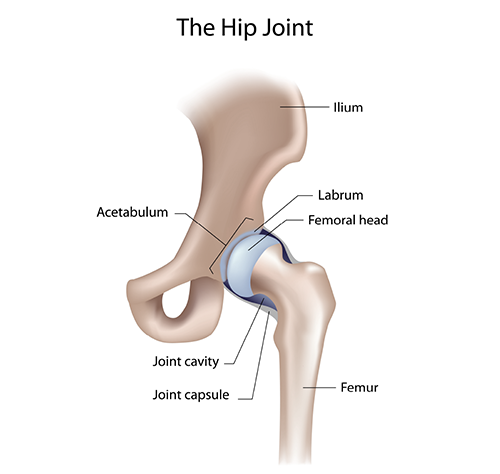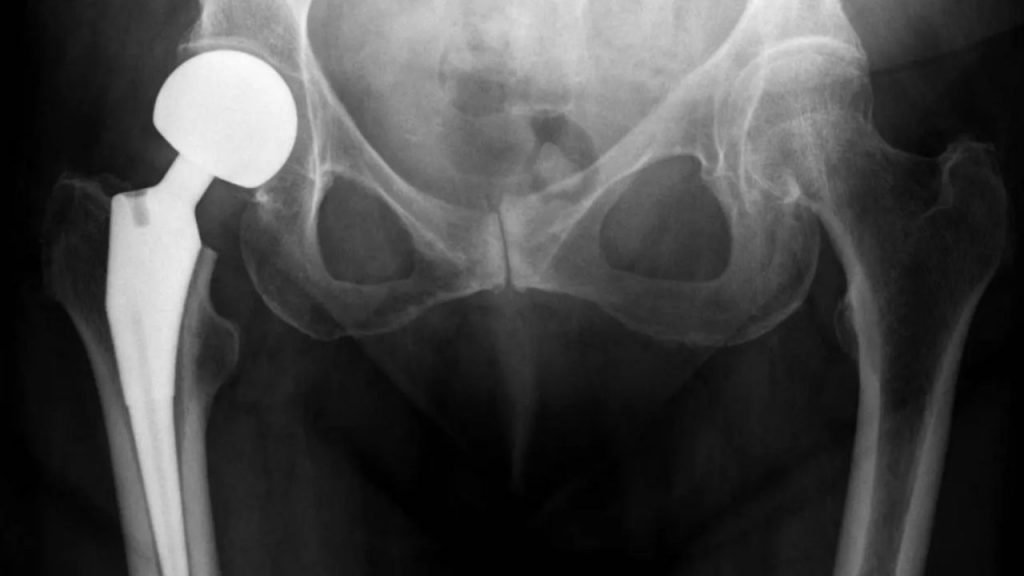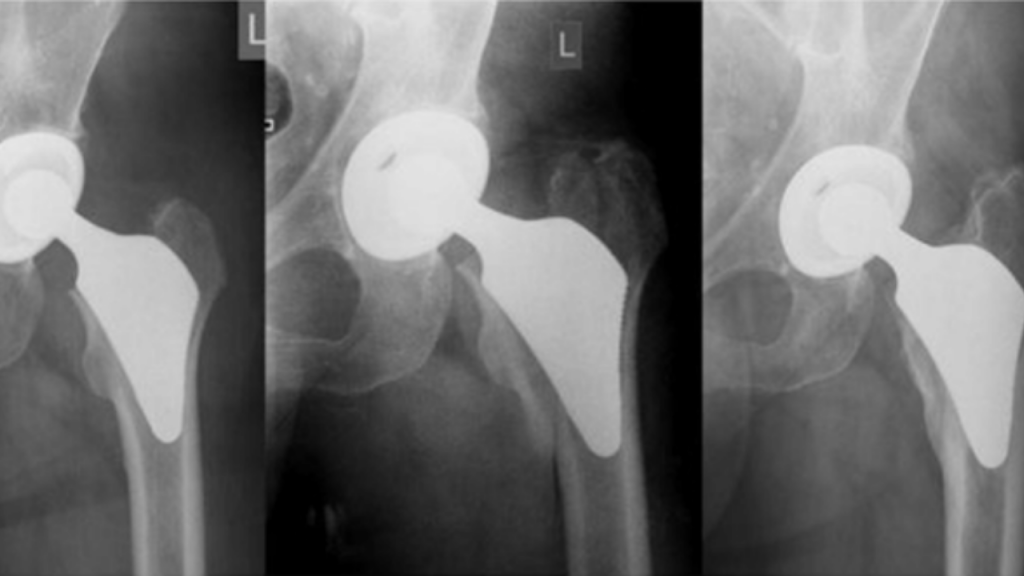HIP Replacement Surgery in Noida, India
Let’s Consult Top Rated Orthopaedic Surgeon in Noida & Delhi NCR, India

HIP Replacement Overview
Get Successful Hip Replacement Surgery in Noida
Total Hip Replacement or Arthroplasty (THR) was the pioneering surgery in joint replacements. While surgeons and scientists were exploring various options from the beginning of the 20th century, the credit for development of the Modern hip replacement goes to Sir John Charnley of Wrightington Hospital, UK in the 60s. Dr Rathore considers himself very fortunate to have received a significant part of his training in this esteemed organisation, which laid the foundation for his practice in joint replacement surgeries.

Today Hip replacements are the second most commonly performed joint replacement surgery benefitting millions of patients across the world.
The Hip Joint : This is a large joint which joins the leg to rest of the body and offers a large range of movement owing to its ball and socket design. The cup is called the acetabulum and the ball part is known as the femoral head.
Why is Total Hip Replacement surgery done?
Get relief from hip pain - Let's Consult the best Hip Joint Surgeon in Noida
There are several conditions which can lead to severe pain emanating from the hip joint. The wear or destruction of either the surfaces of the hip or the whole of the ball part of the hip is called arthritis. This Can result from several conditions like primary osteoarthritis, avascular necrosis of the hip, rheumatoid arthritis, ankylosing spondylitis and occasionally due to injuries.
A hip replacement may sometimes also be performed when there is a fracture around the hip joint. In India there is a larger percentage of younger patients presenting for hip replacement due to higher prevalence of avascular necrosis and ankylosing spondylitis. Most of the patients who are offered this surgery are in significant pain and have stiffness of the hip.
The pain is most commonly felt in the front (groin) and also radiates down the front of the thigh. Patients may have a limp and sometimes the affected leg may have length discrepancy as compared to the other side.
What is Total Hip Replacement?
Total Hip Replacement Surgery in Noida
When the articulating surfaces (the surfaces which rub against each other) become worn or damaged, the components (ball and socket) are both replaced with artificial prosthesis of different designs which are grouped together as total hip replacement or THR.
Types of Hip Replacement

Standard THR
These are all based on early design philosophies of Sir John Charnley and subsequent evolutions. The acetabulum of prepared and a prosthetic cup is inserted and the femoral head is excised and a stem is inserted in the femoral canal on which the ball part sits. These are the most successful and widely used joint replacements.

Hip Resurfacing
The modern Hip resurfacing surgery started with the Birmingham Hip Replacement and was becoming an extremely popular option for younger and more active groups of patients. However, there were certain complications with the procedure (metallosis, loosening and fractures) which has led to disrepute for the procedure and it’s now reserved for a very small select cohort of patients.

Hip Hemiarthroplasty
In this form of surgery only the ball part of the hip is changed leaving the native cup Intact. This process is mainly reserved for hip fractures in the elderly where the cup part of the hip joint is intact.

Short Stemmed THR
Various designs have been developed and are being studied but since they have not shown any superiority or advantages to traditional THRs they have not gained widespread use.
Consult the best HIP Replacement Surgeon in Noida
Types of HIP replacement based on bonding techniques
The hip replacement prosthesis is attached to the native bone either by a substance called bone cement or through techniques which allows the bone to grow and anchor the implants.

Cemented THRs
Most of the earlier THRs were anchored to the native bones using a substance called bone cement or poly methyl methacrylate (PMMA) which acts like a grout between the implant and the patient’s bone. It has a long proven track record of efficacy and safety.
The main disadvantage of PMMA has been loosening which has prompted scientists to look for alternative materials and techniques.

Uncemented THRs
Due to concerns about loosening of implants with time and breaking of the cement bond between the patients bone and implants, several types of implants which do not use bone cement but allow for the patients bone to grow on the implant or coat the implant in a substance which allows the bone to grow into it have been developed. These have gained widespread use but are costlier than the cemented implants. However not all uncemented implants have shown superiority over cemented implants especially when it comes to the femoral stems and cemented implants still retain wide use.

Hybrid implants
Occasionally one component of the THR is cemented and the other is uncemented. The philosophy behind this is to use the best of both worlds.
Uncemented cups have shown superiority over uncemented ones.Well operated stems (Both cemented and uncemented) tend to do well and some surgeons prefer to use an uncemented cup and a cemented stem.
TYPES OF THR BASED ON BEARING
(Articulating Surfaces)
Probably one of the most important parts of a THR is the articulation, or the surfaces where the ball moves against the cup. These surfaces are subject to frictional forces and wear and surgeons, scientists and manufacturers devote considerable effort, time and resources to develop surfaces that have minimal wear and last the longest.
The types of materials used for bearing surfaces are metal (Stainless steel (SS) , Cobalt Chrome (CoCr) alloys etc), plastics (Polyethylene, HDPE, highly cross linked HDPE) and ceramics (Delta, Forte, oxinium etc)

Metal on Poly (MOP)
These are the most commonly used Hip replacements. The original modern hip replacement developed by Sir John Charnley at Wrightington Hospital used an SS ball against plastic cups. Most of these performed very well for a few decades but showed wear after that prompting development of newer articulating surfaces. Most of the metal heads used these days are cobalt Chrome alloys which are very hard and smooth. The plastic cups have also evolved considerably with High density polyethylene and newer highly cross linked polyethylene, which are the preferred materials for the cups.
The main disadvantage of PMMA has been loosening which has prompted scientists to look for alternative materials and techniques.

Ceramics
Ceramics offer various advantages over the traditional Hip replacements as they are very hard, smoother and very resistant to wear. However they are also very expensive which restricts their use.
Ceramic on poly(CoP) and Ceramic on Ceramic (CoC) have shown the least amount of wear and probably last the longest. Because of the high cost especially of the latter these are more commonly offered to the younger patients.

Surgical Technique:
There are several approaches to hip replacement. They are usually described on the basis of in which direction the hip is entered. Anterior (front), lateral (side), posterior (back) and transtrochanteric (through cutting the bone).
All the approaches have their distinct advantages and disadvantages. Surgeons should use an approach they are trained in and are comfortable with.
Dr Gaurav Rathore is adept at all approaches to the hip and uses the approach best suited to every particular surgery.
Rehabilitation - Total Hip Replacement
THR surgery has come a long way in its post operative rehabilitation. With current surgical techniques, modern techniques of anaesthesia and pain relief it’s even possible to discharge some patients the very same day of the surgery. Though day care surgery for hip replacement is not well established and is also subject to certain criticisms, most patients of hip replacements start walking the very next day.
Dr Rathores enhanced recovery protocols allow the patients to regain most of their functional abilities very quickly. Hospitalisation has been reduced to 3-4 days for a majority of the patients and independent mobilisation takes only a few days.
Most patients of THR lead a completely normal life with very few restrictions on their abilities. This has made it one of the most successful orthopaedic surgeries.
Risks and complications of THR
THR is one of the safest and most predictable surgeries. It has changed the lives of millions of patients over the last 5 decades and continues to be one of the most commonly performed surgeries across the world. The risks of surgery are low and the most serious risks can be infection, dislocation, DVT and premature loosening of the joint. Among the other risks are leg length discrepancies, fractures, nerve or vessel injuries. The understanding and early identification of these risk factors has minimised the risks and also made it possible to salvage most of these. Dr Rathore also specialises in revision surgery for any of these complications and takes referrals for these from not only all of India but internationally as well.
Patient's Feedback
Let's see what our patient say about treatment experience and relief

About Dr Gaurav Rathore
Best Knee Replacement Surgeon in Noida, India
Dr Gaurav Rathore is a senior orthopaedic surgeon and additional director for Orthopaedics and joint replacement at the Magenta Clinic and Jaypee Hospital, Noida. He has nearly 22 years experience in Orthopaedics with 11 years in some of the best centres in the UK, including Wrightington hospital, England, the pioneering hospital for joint replacements in the world.
He also has experience of practising in few of the premier Hospitals in UK including University Hospitals of Morecambe Bay NHS Trust, John Radcliffe Hospital, Oxford, Chesterfield Hospital, SWELOC, London etc.
In 2013, he moved to India bringing world class Orthopaedic care to Delhi NCR. He has worked at a senior level at Sant Parmanand Hospital, Civil Lines; Fortis Escorts, Okhla and Fortis Hospital, Noida. He has been heading an orthopaedic unit at Jaypee Hospital, Noida since 2015. Know More…
Consult the best HIP Replacement Surgeon in Noida
HIP Joint Replacement Surgery in Noida, India
Dr. Gaurav Rathore – Top Rates Hip Replacement Surgeon in Noida
HIP is very important parts of our body. It also plays very important role in our body movement. If we have pain in our HIP then it reduce the quality of our life. When we suffer from the pain in our hip joint then it also make an impact on our regular living. If we feel any kind of pain in our hip then we must consult orthopaedic surgeon or joint specialist in Noida, India.
Dr. Gaurav Rathore is top rated orthopaedic and HIP joint replacement surgeon in Noida, India. If you’re looking for best joint replacement surgeon in Noida (Delhi NCR), the you must consult Dr Gaurav Rathore for HIP treatment and cost effective HIP joint replacement surgery in Noida.
Contact Us
Consult us for the best hip Surgery in Noida
Book An Appointment
Address: HA103 Ground Floor, Hazipur, Sector 104, Noida, Uttar Pradesh 201304
Mobile : +91-99908 88358




